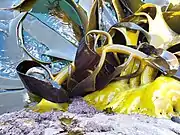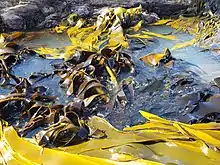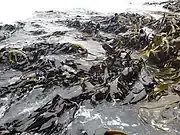Durvillaea willana
Durvillaea willana is a large species of southern bull kelp endemic to New Zealand.[1][2][3][4]
| Durvillaea willana | |
|---|---|
 | |
| D. willana at Watsons Beach, Otago, with the epiphyte Pyrophyllon subtumens growing on the middle plant . | |
| Scientific classification | |
| Domain: | Eukaryota |
| Clade: | Diaphoretickes |
| Clade: | SAR |
| Clade: | Stramenopiles |
| Phylum: | Gyrista |
| Subphylum: | Ochrophytina |
| Class: | Phaeophyceae |
| Order: | Fucales |
| Family: | Durvillaeaceae |
| Genus: | Durvillaea |
| Species: | D. willana |
| Binomial name | |
| Durvillaea willana | |
Etymology
The species epithet, willana, honours Eileen Alice Willa who collected many algal species for Lindauer.[1]
Description
This species is chocolate brown in colour and is darker than all other bull kelp species.[4][5] It has a branched stipe.[3] The species is non-buoyant and does not have 'honeycomb' in its fronds.[3][4] The holdfast becomes large and spreads like a plate on rocky substrates.[6]
This species is superficially similar in appearance to Durvillaea antarctica.[6] However, D. willana has smaller blades than D. antarctica and is usually found lower on the shoreline because its lower tolerance of wave action comparded D. antarctica.[6] It also has a branched stipe and does not have buoyant fronds, unlike D. antarctica.[3]
 D. willana growing on Taieri Island, showing the distinctive branched stipe and dark colouration
D. willana growing on Taieri Island, showing the distinctive branched stipe and dark colouration D. willana surrounded by other Durvillaea on Taieri Island, Otago
D. willana surrounded by other Durvillaea on Taieri Island, Otago Many D. willana growing at Watsons Beach, Otago
Many D. willana growing at Watsons Beach, Otago.jpg.webp) Prepared specimen of D. willana
Prepared specimen of D. willana
Distribution
This species of kelp is endemic to New Zealand and is found on the southeastern shores of the North Island, although not in Cook Strait, as well as on the shores of the South Island and Stewart Island.[1][2][3][4][7][8]
Gaps in the geographic range of the species may have been caused by earthquake uplift events such as the 1855 Wairarapa earthquake.[4] However, historic uplift (800 - 1400 years before present) in the Akatore fault zone does not seem to have caused any long term disruption in the genetic diversity of D. willana, in that region.[8] This result suggests that the subtidal D. willana may not die-off completely due to earthquake uplift events.[8]
References
- Lindauer, V.W. (1949). "Notes on marine algae of New Zealand. I". Pacific Science. 3: 340–352.
- Fraser, C.I.; Winter, D.J.; Spencer, H.G.; Waters, J.M. (2010). "Multigene phylogeny of the southern bull-kelp genus Durvillaea (Phaeophyceae: Fucales)". Molecular Phylogenetics and Evolution. 57 (3): 1301–11. doi:10.1016/j.ympev.2010.10.011. PMID 20971197.
- Fraser, Ceridwen I.; Velásquez, Marcel; Nelson, Wendy A.; Macaya, Erasmo C.A.; Hay, Cameron (2019). "The biogeographic importance of buoyancy in macroalgae: a case study of the southern bull‐kelp genus Durvillaea (Phaeophyceae), including descriptions of two new species". Journal of Phycology. 56 (1): 23–36. doi:10.1111/jpy.12939. PMID 31642057.
- Hay, Cameron H. (2019). "Seashore uplift and the distribution of the bull kelp Durvillaea willana Lindauer in New Zealand". New Zealand Journal of Botany. 2019 (2): 94–117. doi:10.1080/0028825X.2019.1679842. S2CID 208593399.
- Carson, Sally Fraser; Morris, Rod (2017). Collins field guide to the New Zealand seashore. Auckland, New Zealand: Harper Collins. p. 357. ISBN 9781775540106. OCLC 1012909625.
- Bradstock, M. C. (1989). Between the tides : New Zealand shore and estuary life (Rev. ed.). Auckland, N.Z.: David Bateman Ltd. ISBN 1869530055. OCLC 154713066.
- Nelson, W.A. (2013). New Zealand seaweeds : an illustrated guide. Wellington, New Zealand: Te Papa Press. p. 70. ISBN 9780987668813. OCLC 841897290.
- Parvizi, Elahe; Fraser, Ceridwen I.; Dutoit, Ludovic; Craw, Dave; Waters, Jonathan M. (2020). "The genomic footprint of coastal earthquake uplift". Proceedings of the Royal Society B. 287 (1930): 20200712. doi:10.1098/rspb.2020.0712. PMC 7423469. PMID 32635859.
External links
- Algaebase: Durvillaea Lindauer
- Museum of New Zealand Te Papa Tongarewa: Durvillaea willana Lindauer (Species)